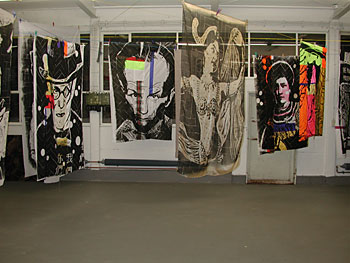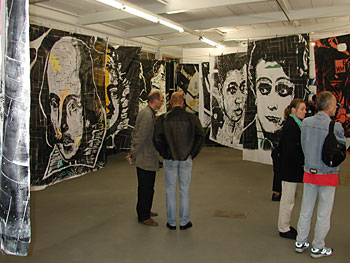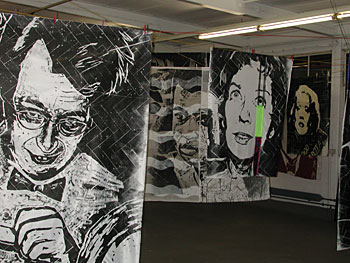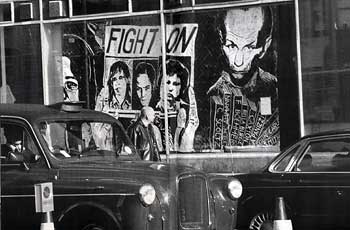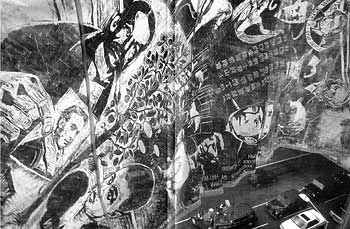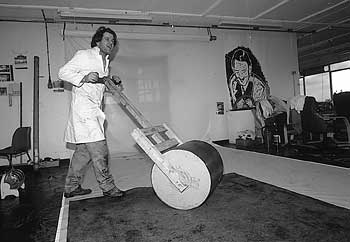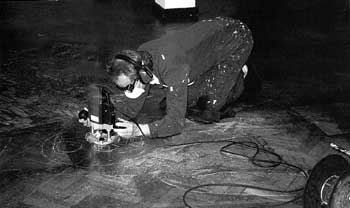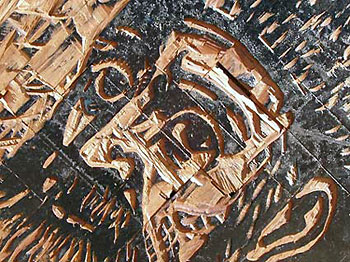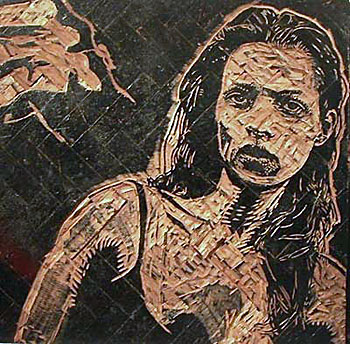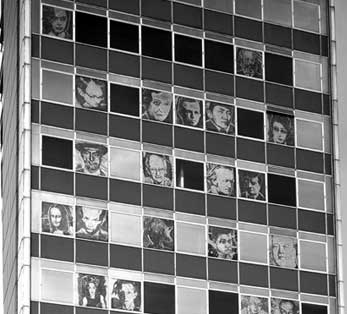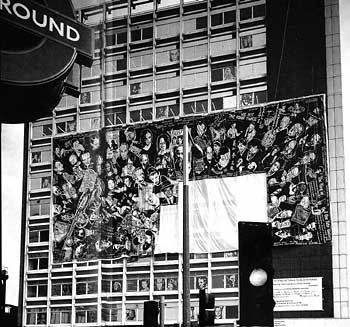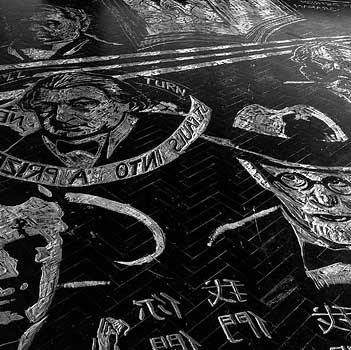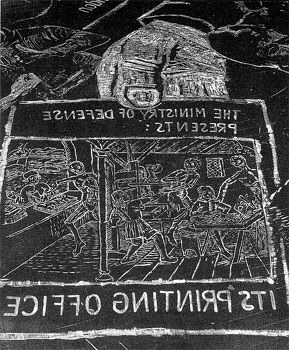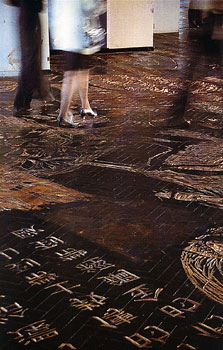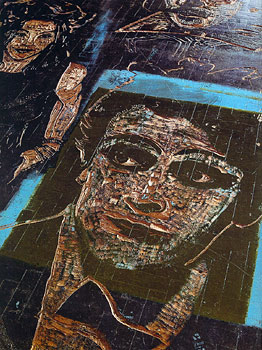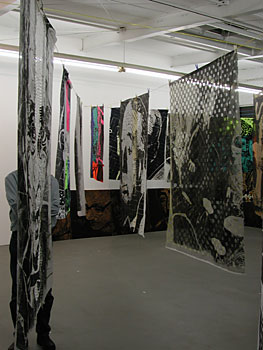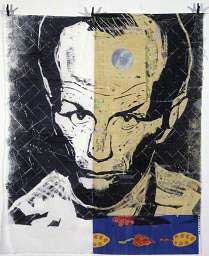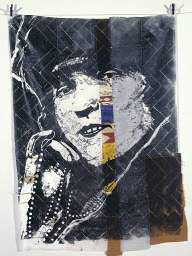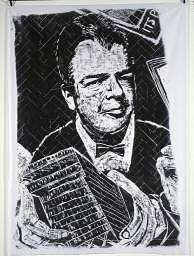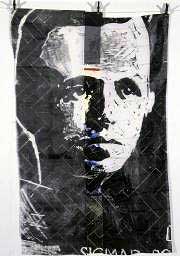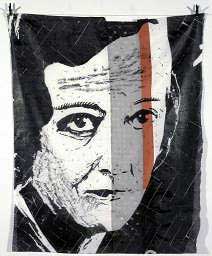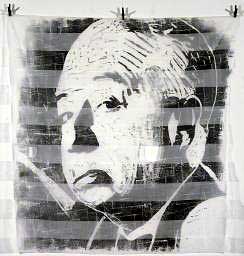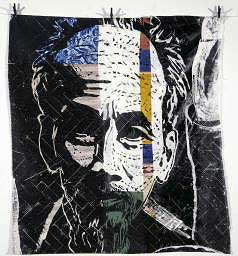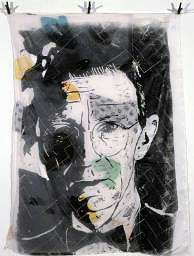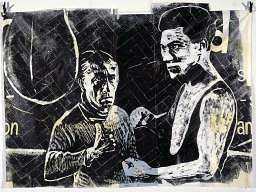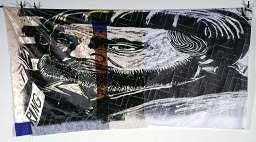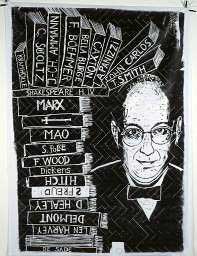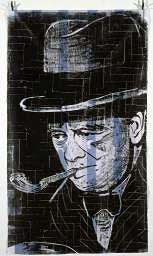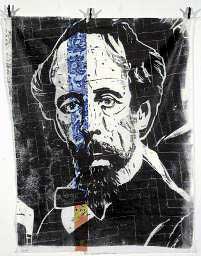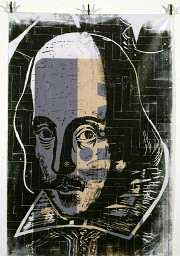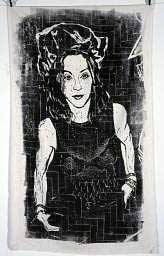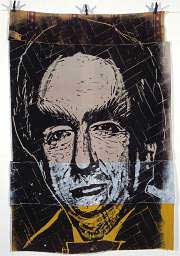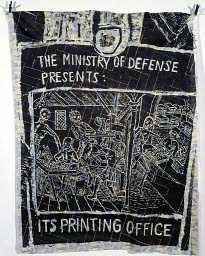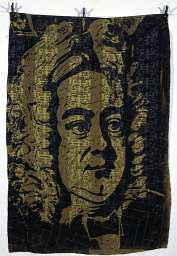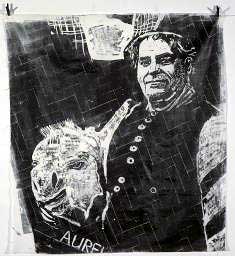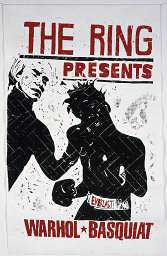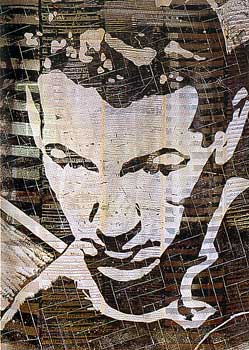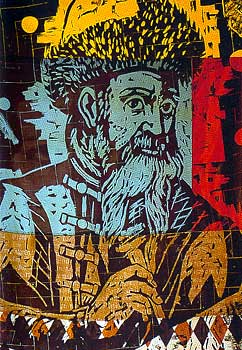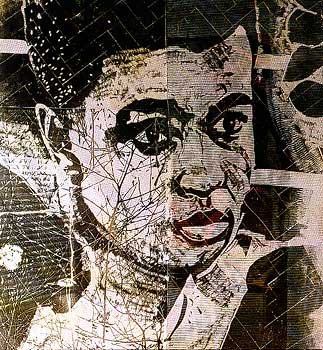The Ring
Woodcut Project 1999-2000
Orbit-House, 197 Blackfriars Road, London
Over a period of 12 months The Ring, a 400 sqm woodcut in the parquet flooring on the 10th floor of an empty office bloc in the centre of London, came into being. In the building the Oriental Collection of the British Libray was located and as part of its Collection the oldest woodcut of the world, the Diamond Sutra from China, stored.
About 70 portraits from famous and unfamous personalities, all with a certain connection to the site, appeared on the façade and made the building reviving. Boxers, politicians, artists, popstars…
During the exhibition, which was organised by the South London Gallery (David Thorp) the entire print was hanging on the façade and like a squatter’s banner waving in the wind.
Parallel to the show and in reference to the site four lectures were given: from the head of the Oriental Collection of the British Library, from the president of London’s Ex-Boxer Association (in the 1920’s on the very spot was a popular boxing ring), from Sandy Nairne (Tate Gallery, which opened its new Gallery, Tate Modern a stone-throw away) and from the architect in charge to redevelop the site, Prof. Will Alsop, who spoke about the future of the site and of South London.
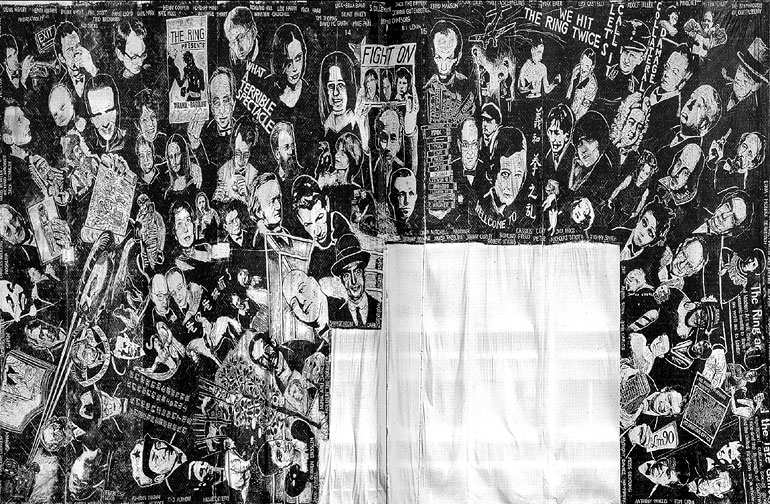
On the tenth floor of Orbit House, an abandoned office block in Blackfriars Road, Southwark, Thomas Kilpper has produced a four hundred square metre woodcut. For the last five months, carving directly into the mahogany parquet floor of the building, Kilpper has inscribed it with its own histories, presenting a map of the vast socio-cultural, political and economic changes happening in Southwark over a period of more than two hundred years. We can chart the various changes in social organisation, politics and economics from the Christian uses of the site in the eighteenth and nineteenth centuries to the current advent of cyber-capitalism.
Kilpper’s use of woodcutting, the oldest form of printmaking, is highly significant. Appearing in Europe at the beginning of the fifteenth century, woodcuts were used to reproduce knowledge, literally inscribing events in history. One of the major shifts in worldview that came with the invention of the printing press in this period was the notion that the natural world is just passively waiting for us to appropriate it.
Kilpper’s narrative commences in 1780 when the octagonal Surrey Chapel was constructed on the site by the charismatic Reverend Rowland Hill, who was known to draw congregations of over a thousand to his services. The chapel was eventually abandoned in 1890 when it became Green & Sons Engineering Ltd, and then a furniture warehouse in 1905. Between 1907 and 1909 the building was converted into one of London’s first cinemas, returning it to its original function as an arena of glamour, ritual and escape. Kilpper’s interest in the relationship between spectacle and the historical erasure tallies well with this period of cinematic history. At the beginning of the twentieth century, actors were rarely given credit for their film work. Many of the early actors came from a theatre background, wherein film work was considered inferior. Often they did not want to be recognised in the films.
Designated as an entertainment venue, the building became the popular boxing arena known as The Ring. From 1910 to 1940, it played host to some of the most famous boxers in London. During this period sports such as boxing became one of the central sites in the social production of masculinity in Western societies. Many attempts had previously been made to link combative sports with moral strength – such as in the muscular Christianity – espoused by leading Victorian headmasters. This was particularly conspicuous in the period spanning the two World Wars, when the boxing ring became an arena for the development of physical presence, stoic courage in the endurance of pain, and judgement under pressure – unequivocally military values which were then portrayed as essential parts of the achievement of manhood.
Kilpper weaves the ideological role of boxing with more personal recollections of the sport, representing figures such as Mohammed Ali and Henry Cooper. This again fosters the leitmotif of the relationship between celebrity and historical erasure in The Ring. Boxing fame is particularly fickle and transient. We remember Ali and Cooper but, like greyhounds and racehorses, most boxers come and go. In The Ring, Kilpper draws parallels with the artworld, including a portrait of Leo Castelli alongside Tony Shafrazi and Bruno Bischofberger’s famous poster of Warhol vs. Basquiat (1985), which depicted the artists preparing for a boxing match. Like a successful boxing promoter, Castelli’s reputation outlasted his clients’ careers. Of unsuccessful abstract expressionists, he once said “they accuse me of killing them; they blame me for their funerals. But they were dead already. I just helped remove the bodies”
During this period the building doubled as a theatre and music hall, where the music of Wagner and Handel could be heard. The Old Vic Company – with Robert Atkins and Leslie French – performed Shakespeare’s Henry IV at The Ring. (The original ring, Shakespeare’s legendary Globe Theatre, had not yet been reconstructed.) Alfred Hitchcock used The Ring as the set for his 1926 silent movie of the same name, in which a boxer falls in love with the ticket girl. Hitler also left his mark on the site. Nazi air raids struck The Ring twice, bringing an end to boxing and theatre at Blackfriars Road.
The current office building, Orbit House, was erected in the sixties for the Ministry of Defence, commissioned by Dennis Healey to house the secret printing office of The Army. Kilpper illustrates this era by reproducing the first Western representation of a printing office, The Dance of Death (Lyon c.1500). This macabre image raises the history of print as an instrument of control. The Church’s monopoly on information during the manuscript book period ended with the arrival of print. European nation states flourished as the world could now be mapped without recourse to religious propaganda. The world was no longer unknown, but a manageable, controllable resource to be exploited. (A replica of Francis Drake’s sixteenth century galleon the Golden Hinde, docked adjacent to Orbit House, testifies to this.) As a eurocentric world economy flourished, armies and attendant nationalist propaganda were needed to protect and develop the new colonial markets. Thus print liberated and imprisoned simultaneously.
tory. Some become symbols, monuments even that are recognised throughout the world – the Houses of Parliament and Big Ben, St Pauls Cathedral, etc. Most of us appreciate that even the most mundane buildings around us have potentially fascinating histories but very few of us make the time to investigate these histories. Thomas Kilpper is someone who does.
Kilpper, who was born in Stuttgart, arrived in London in the spring of 1999. He had just completed a residency in a gymnasium at the aLandoned US military base of Camp King in Oberursel, outside Frankfurt. During his time there he carved images of the history of the base, alongside images of his own biography, directly into the wooden parquet floor. Kilpper had come to London in scarch of a building in which to do a similar residency. He was immediately drawn to Southwark, initially because of the high profile regeneration this impoverished area was undergoing. This regeneration was symbolised by the reinterpretation of significant buildings – the Tate Modern, Shakespeares Globe Theaire, the new Peckham Library. Kilpper systematically researchod abandoned buildings in the area and found Orbit House, an anonymous 1950s office block. Orbit House and Camp King share an important similarity. Both were goverument built, for secretive, even sinister, purposes.The general public were only ever admitted to them under strictly controlled conditions. Kilpper exposed the secret histories of these two places by permanently carving those histories into the very fabric of the buildings. Orbit House in particular was to be dramatically exposed when Kilpper hung a full size print of his carving onto the front of the building, for all to see.
Kilpper approaches his work first and foremostly as an artist and it is because of this that the work evolves and develops in the way that it does. He is categorically not a social historian. As well as digging deeply to uncover the stories of people who have been long forgotten he introduces elements of his own history, interests, the people he meets and his political opinions into the ever-expanding narrative. This process runs concurrently with Kilppers physical intervention in the space itself. He chisels images from the stories he has uncovered directly inlo the parquet of the floor, chipping away at the building itself. The finished work is big, very big, 400 square metres in the case of Orbit House, and takes many arduous months to complete.
The uncovering of Orbit House began when Kilpper discovered that a very well known boxing ring, called The Ring, used to occupy the site. The landlord of the pub across the road told him about the rise and fall of The Ring. Leads emerged, characters entered and exited the narrative leaving behind their images in the floor of Orbit House. As Kilppers contacts grew and stories and links emerged so the image itself spread out further into the floor. The sheer amount of information that Kilpper managed to unearth was astounding. He discovered that the boxing ring actually occupied an 18th Century octaponal chapel. The chapel itself had many interesting stories to tell, all recounted by Kilpper in the work. It was eventually destroyed during the Blitz when it was bombed by the Luftwaffe, and Orbit House was built in its place, ironically, by the Ministry of Defence to house their secret printing offices. The building then fell into the hands of the British Library, who used it to house their Oriental Collection.
But it is the real people who really existed and who played a part in the history of that small part of London that Kilpper brought back to life. What his work demonstrates is that the vast potential of the past is close to us all the time if we only choose to investigate it. Looking at Kilppers work is like talking to an elderly relative about the times in which they lived, times that have gone forever. There could be a terrible sadness in that. That all these people who lived their lives as fully as we live ours have come and gone and been forgotten.
But Kilppers work is overwhelmingly positive. His art makes us think about how often we overlook our environment, by using the narrative form to bring it to life for us. He makes us aware of our continuing relationship with the past and our individual contriLutions to an ever-evolving history. The past is alive and well and real and to be found, sometimes in the strangest of places.
Donna Lynas
Curator, South London Gallery
Thomas Kilpper approached the South London Gallery to ask for support to allow public access to his work at Orbit House. This we happily agreed to do as part of our SLG Projects initiative, a scheme that enables us to commission and exhibit work outside of the Gallery context. The Ringwas opened by us from 11 to 26 March 2000.
The future of Kilppers work at Orbit House is uncertain. The building will be demolished and the work very likely with it. Alsop and Störmer, architects of the new building, proposed to absorb the work into their design but there is hesitation to this from the owners of Orbit House. However, a small section of the carving will be preserved. It has been bought, along with several prints, by the Tate Modern for their collection. (D. L.)
Rowland Hill Reverend + Founder of the Surrey Chapel
Len Harvey – Dick Burge – Alf Manzini – Fredie Mills – Jack Hood – Billy Wells – Jack Stanley – Phil Scott – Jack Powell – Kid Socks – Johnny Curley – Georges Carpentier Boxers of “The Ring”
Muhamad Ali – Henry Cooper Boxers
Moss de Young Referee of The Ring
George Harris Master of Ceremonies at The Ring
Dan Sullivan Manager of Boxers e.g. Len Harvey
Bella Burge Manager of The Ring
Text {Bella Burge):’Welcome to the boxer rebellion” with Chinese characters: justice, peace, fist, rebellion
Marie Lloyd Musical Singer, adopted Bella Burge
The 8th Marquess of Queensberry established boxing rules
Apple Tree
Alfred Hitchcock Film Director, used The Ring as a set for his silent movie “The Ring”, 1926
Carl Brisson Actor, the boxer in Hitch’s movie “The Ring”
Gordon Harker Actor, the trainer in Hitchcock’s movie “The Ring”
John Mumford conservator, Oriental Collections of British Library (OIOC) worked in Orbit House
Tim Thomas Readers Service of OIOC, worked in OH
A book pile
Japanese wood cut (genitals of a whore, from a brothel guide, late 18th century)
The Diamond Sutra from 868 AD oldest printed book, belongs to OIOC, was stored in Orbit House
Sir Aurel Stein rediscovered the Diamond Sutra, brought it from China to London
Johannes Gutenberg “inventor” of movables types (1452)
William Caxton printed the first book in English, 1475
Anthony Panizzi Italian rebel, one of the founders of the British Museum and British Library, commissioned the round reading room of the B.L.
Charles Wilkens started printing and collecting books and prints for the India Office
Patrik Wright Managing Director of the British Museum Company
Ivory figurine, about 4000 BC British Museum item No. EA 32141
Charles Dickens Writer, passed Surrey Chapel daily as a schoolboy
William Shakespeare was staged in The Ring
Ho-Chi-Minh Vietnamese politician and revolutionary
Andreas Baader – Gudrun Ensslin – Ulrike Meinhof – Monika Berberich Members of the Red Army Faction who began their fight alongside the Vietcong
Benno Ohnesorg Student, shot dead by police in !t a demonstration against the Persian Shah, Berlin 1967
Hilary Cresk Member of the Angry Brigade, about 1975
Bobby Sands died in prison during a hungerstrike, Member of Parliament and of the IRA
Guy Debord Philosopher, Situationist, wrote “The Society of Spec
tacle”
Denis Healey Politician, MOD, commissioned Orbit House
The oldest medival representation of a printing office Lyon 1500, Dance of Death.
Soldier woman showing her breasts when the Royal Navy left the harbour for the Falklands War
Winston Churchill Member of the India Of fice Cavalry
Adolf Hitler The Luftwaffe bombed The Ring twice
Karl Barth was head of the Nazi’s interrogation centre of the Luftwaffe in Oberursel
A Bomber from the Blitz
Robert Atkins Actor and theatre maneger of The Old Vic organised the performances of Shakespeare in The Ring
Leslie French Actor, performed Shakespeare in The Ring
Mata Hari Dancer, was executed during the First World War as a spy by the French Military
Madonna Singer, actor
Marlene Dietrich actor
Kate Moss model
Mona Lisa
Leo Castelli American gallerist, died 1999, represented Warhol among others
Advertising Text of the Tate Gallery, slightly modihed :” The Ring and the Tate Gal lery of Modern Art will bring signifocant cultural, social and economic benehts to the Borough of Southwark, to London and to the UK as a whole “
Will Alsop Architect, commissioned to redevelop the site “Southpoint”
Stuart Bailey Landlord of Orbit House
Johnny Spence – Stephan Dillemuth – Josephine Pryde – Merlin Carpenter – Alex Hamilton – Sarah Staton – Dan Mitchell – Anthony Davies Artists, friends
Rosalina Glogan Baby of artists and friends, born 1999
Thomas Kilpper on his knees in play pen
Gilbert & George – Andy Warhol – Michael Basquiat – Sigmar Polke – Holbein the Younger Artists
Henry Abraham Kilpper’s neighbour in East London, was a teenage spectator at The Ring
Klara Kilpper T.K’s grandmother, lived in China
Gerhart Kilpper T K’s father, born in China
Irmgard Kilpper Gerhart K’s sister lived in China
Martin Kilpper T. K’s brother
Michael Schumacher Racing Driver, F 1
Louisa Raeburn
Mao Tse Tung Chinese revolutionary, philosopher and politician
Chinese text (Mao): “We took some of your missioners to the mountains, you took our Diamond Sutra to Europe, we gave them back, you did not”
Sigmund Freud came as a refugee to London
Karl Marx wrote “Das Kapital” in The British Lihrary
I. Lenin lived some years in London
Mrs or Mr Pig – Mrs and Mr Rat – Erna the Crow – Mr Fox
Richard Wagner Composer of “The Ring”
Hans Richter conducted Wagner’s Ring for the first time
G. F. Händel Composer of the Messiah
Sir George Smart conducted Handel’s Messiah on the site
Tommy Smith sprinter, Olympicgold medallist 1968, he reised his black-gloved first as a sign of protest
John Carlos Sprinter Olympic silver medallist 1968, he protested together with Tommy Smith.
A film projector from 1907, when the chapel wasacinema
Wall painting crying Asian child opposite Hackney Town Hall.

